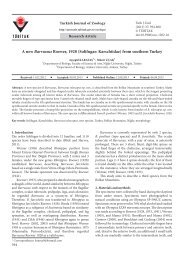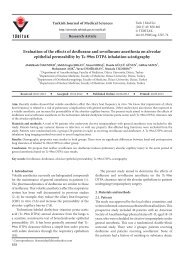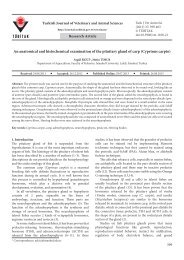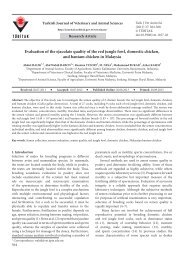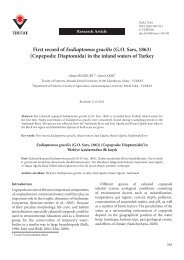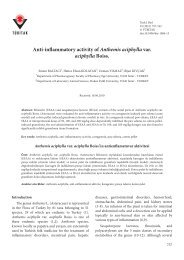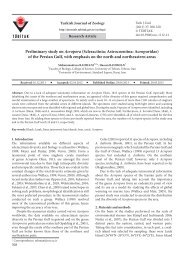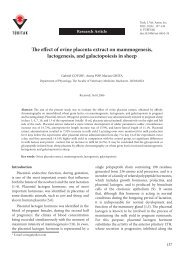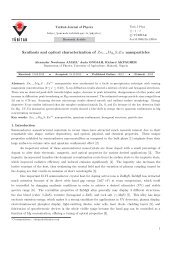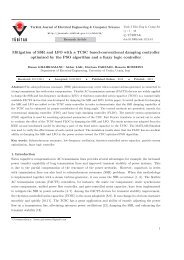Messinian forced regressions in the Adana Basin: a near ... - Tübitak
Messinian forced regressions in the Adana Basin: a near ... - Tübitak
Messinian forced regressions in the Adana Basin: a near ... - Tübitak
You also want an ePaper? Increase the reach of your titles
YUMPU automatically turns print PDFs into web optimized ePapers that Google loves.
part is covered with th<strong>in</strong>ly bedded reefal limestones, which<br />
<strong>in</strong>dicates a shallow drown<strong>in</strong>g, cessation of fluvial supply,<br />
and thus a considerable landward shift of <strong>the</strong> shorel<strong>in</strong>e.<br />
There are no younger mar<strong>in</strong>e deposits <strong>in</strong> <strong>the</strong> bas<strong>in</strong>, which<br />
implies its subsequent emergence. Taken toge<strong>the</strong>r, <strong>the</strong><br />
evidence <strong>in</strong>dicates a <strong>forced</strong> regression followed by limited<br />
mar<strong>in</strong>e reflood<strong>in</strong>g, and <strong>the</strong> delta’s association with <strong>the</strong><br />
upper part of <strong>the</strong> Tırtar Formation might thus render it<br />
correlative with <strong>the</strong> deltas <strong>in</strong> <strong>the</strong> <strong>Adana</strong> Bas<strong>in</strong>. In reality,<br />
<strong>the</strong> delta <strong>in</strong> <strong>the</strong> Mut Bas<strong>in</strong> is significantly older than <strong>the</strong><br />
deltas <strong>in</strong> <strong>the</strong> <strong>Adana</strong> Bas<strong>in</strong>, as evidenced by biostratigraphic<br />
data.<br />
The age of <strong>the</strong> deltaic deposits <strong>in</strong> <strong>the</strong> Mut Bas<strong>in</strong> has<br />
been determ<strong>in</strong>ed on <strong>the</strong> basis of planktonic foram<strong>in</strong>ifera<br />
<strong>in</strong> 10 mudstone samples from a vertical outcrop section<br />
of <strong>the</strong> delta bottomset deposits. Planktonic foram<strong>in</strong>ifera<br />
are abundant and well preserved, but show a relatively low<br />
to moderate diversity and are accompanied by benthic<br />
foram<strong>in</strong>ifers (representatives of Ammonia, Elphidium,<br />
Bulim<strong>in</strong>a, Boliv<strong>in</strong>a, Uviger<strong>in</strong>a, Nonion, miliolids, and<br />
nodosarids), gastropods, bivalves, ostracods, and<br />
ech<strong>in</strong>id sp<strong>in</strong>es. The dom<strong>in</strong>ant planktonic species are<br />
Globiger<strong>in</strong>a and Globiger<strong>in</strong>oides, accompanied by<br />
abundant globoturborotalids, neogloboquadr<strong>in</strong>ids, and<br />
orbul<strong>in</strong>ids. All samples consistently conta<strong>in</strong> Globiger<strong>in</strong>a<br />
bulloides d’Orbigny, Globiger<strong>in</strong>oides trilobus (Reuss), G.<br />
quadrilobatus (d’Orbigny), G. obliquus Bolli, G. bulloideus<br />
Crescenti, Globiger<strong>in</strong>ella obesa (Bolli), Neogloboquadr<strong>in</strong>a<br />
acostaensis (Blow), N. cont<strong>in</strong>uosa (Blow), and<br />
Globoturborotalita woodi (Jenk<strong>in</strong>s). Species that are less<br />
consistently present or rare <strong>in</strong>clude Globoturborotalita<br />
decoraperta (Takayanagi & Saito), Tenuitell<strong>in</strong>ata<br />
angustiumbilicata (Bolli), Catapsydrax parvulus Bolli,<br />
Loeblich & Tappan, Globorotalia scitula (Brady),<br />
Globiger<strong>in</strong>ita uvula (Ehrenberg), Globiger<strong>in</strong>ita <strong>in</strong>crusta<br />
Akers, G. glut<strong>in</strong>ata (Egger), and Globiger<strong>in</strong>oides seigliei<br />
Bermudez & Bolli. The majority are long-range species,<br />
but <strong>the</strong> cooccurrence of Neogloboquadr<strong>in</strong>a cont<strong>in</strong>uosa<br />
(Blow), N. acostaensis (Blow), Globiger<strong>in</strong>oides bollii Blow,<br />
and G. seigliei Bermudez & Bolli <strong>in</strong>dicates a Tortonian age<br />
of <strong>the</strong> deposits. The cooccurrence of <strong>the</strong>se last 3 species<br />
suggests an age probably not older than biozone MMi11<br />
(Figure 9; D’Onofrio et al. 1975; Iaccar<strong>in</strong>o 1985; Iaccar<strong>in</strong>o<br />
et al. 2007). The age can be constra<strong>in</strong>ed fur<strong>the</strong>r by <strong>the</strong><br />
presence of Neogloboquadr<strong>in</strong>a cont<strong>in</strong>uosa Blow, whose last<br />
stratigraphic occurrence <strong>in</strong> <strong>the</strong> Mediterranean is <strong>in</strong> <strong>the</strong><br />
subzone Globiger<strong>in</strong>oides obliquus extremus/G. bulloideus<br />
(Iaccar<strong>in</strong>o 1985) or subzone MMi12a of Iaccar<strong>in</strong>o et<br />
al. (2007). The deltaic bottomset deposits, coeval with<br />
<strong>the</strong> delta built-out, can thus be assigned to <strong>the</strong> biozone<br />
<strong>in</strong>terval MMi11–MMi12a (Figure 9; D’Onofrio et al.<br />
1975; Iaccar<strong>in</strong>o 1985; Iaccar<strong>in</strong>o et al. 2007). The delta<br />
thus appears to have prograded <strong>in</strong> an approximate time of<br />
20<br />
ILGAR et al. / Turkish J Earth Sci<br />
8.5–7.8 Ma B.P., which corresponds to <strong>the</strong> regressive part<br />
(8.3–7.8 Ma B.P.) of <strong>the</strong> third-order eustatic sea-level cycle<br />
TB3.2 of Haq et al. (1988).<br />
In summary, <strong>the</strong> isolated late Tortonian delta <strong>in</strong> <strong>the</strong> Mut<br />
Bas<strong>in</strong>, although seem<strong>in</strong>gly correlative with similar deltas <strong>in</strong><br />
<strong>the</strong> <strong>Adana</strong> Bas<strong>in</strong>, is significantly older. Its development and<br />
drown<strong>in</strong>g were apparently related to a third-order eustatic<br />
sea-level cycle, ra<strong>the</strong>r than local tectonics. There was no<br />
compressional Neogene deformation <strong>in</strong> <strong>the</strong> Mut Bas<strong>in</strong>,<br />
whose marg<strong>in</strong> <strong>in</strong>stead shows normal faults <strong>in</strong>dicat<strong>in</strong>g<br />
postorogenic tectonic extension (Figures 12b and 12c).<br />
The amplitude of eustatic cycle TB3.2 did not exceed 30 m<br />
(Haq et al. 1988), but <strong>the</strong> sea-level change was recognised<br />
<strong>in</strong> several o<strong>the</strong>r peri-Mediterranean bas<strong>in</strong>s (e.g., Rouchy<br />
& Sa<strong>in</strong>t Mart<strong>in</strong> 1992; Larsen 2003; Roveri & Manzi 2006).<br />
However, this eustatic cycle was also modulated by<br />
local tectonics and became recorded differently <strong>in</strong> different<br />
bas<strong>in</strong>s. The mar<strong>in</strong>e reflood<strong>in</strong>g of <strong>the</strong> Mut Bas<strong>in</strong> was<br />
probably outpaced by <strong>the</strong> regional isostatic uplift of <strong>the</strong><br />
Central Taurides, whereby <strong>the</strong> bas<strong>in</strong> became emerged well<br />
before <strong>the</strong> hypersal<strong>in</strong>ity state and evaporative drawdown<br />
of <strong>the</strong> Mediterranean Sea. In <strong>the</strong> <strong>Adana</strong> Bas<strong>in</strong>, this<br />
eustatic cycle went unrecognisable (Figure 2), probably<br />
because <strong>the</strong> low-amplitude eustatic sea-level fall was fully<br />
compensated by <strong>the</strong> postthrust<strong>in</strong>g isostatic subsidence of<br />
<strong>the</strong> foreland bas<strong>in</strong>. In <strong>the</strong> Antalya Bas<strong>in</strong>, <strong>in</strong> contrast, <strong>the</strong><br />
Tortonian succession as a whole is regressive (Flecker et<br />
al. 1995; Deynoux et al. 2005; Ç<strong>in</strong>er et al. 2008), yet shows<br />
no less than 4 cycles of a mar<strong>in</strong>e drown<strong>in</strong>g and renewed<br />
progradation of <strong>the</strong> bas<strong>in</strong>-marg<strong>in</strong> fan deltas (Larsen<br />
2003). Their exact tim<strong>in</strong>g is uncerta<strong>in</strong> and none of <strong>the</strong>se<br />
cyclo<strong>the</strong>ms is recognisably <strong>forced</strong>-regressive, but at least<br />
some of <strong>the</strong>m may be third-order eustatic sequences of<br />
type 2.<br />
These regional comparisons illustrate <strong>the</strong> difficulty<br />
with <strong>in</strong>terbas<strong>in</strong>al stratigraphic correlations and serve as a<br />
warn<strong>in</strong>g aga<strong>in</strong>st a superficial l<strong>in</strong>k<strong>in</strong>g of seem<strong>in</strong>gly similar<br />
events <strong>in</strong> <strong>the</strong> late Miocene peri-Mediterranean bas<strong>in</strong>s (see<br />
also discussions by Clauzon et al. 1996; Soria et al. 2003;<br />
Roveri & Manzi 2006). Reliable stratigraphic correlations<br />
require biostratigraphic constra<strong>in</strong>ts, a good understand<strong>in</strong>g<br />
of <strong>the</strong> bas<strong>in</strong>’s bathymetric conditions and sedimentary<br />
systems, and a careful account of <strong>the</strong> bas<strong>in</strong>’s tectonic<br />
development. False hypo<strong>the</strong>tical correlations of regional<br />
events lead to mistaken regional <strong>in</strong>terpretations.<br />
9. Conclusions<br />
This comb<strong>in</strong>ed sedimentological, sequence-stratigraphic,<br />
and biostratigraphic study of <strong>the</strong> late Miocene deposits<br />
<strong>in</strong> <strong>the</strong> <strong>Adana</strong> Bas<strong>in</strong> has shown that <strong>the</strong> shallow-mar<strong>in</strong>e<br />
Handere Formation of Tortonian–<strong>Mess<strong>in</strong>ian</strong> age,<br />
previously <strong>in</strong>terpreted as a simple regressive succession,<br />
bears a high-resolution record of several major relative



